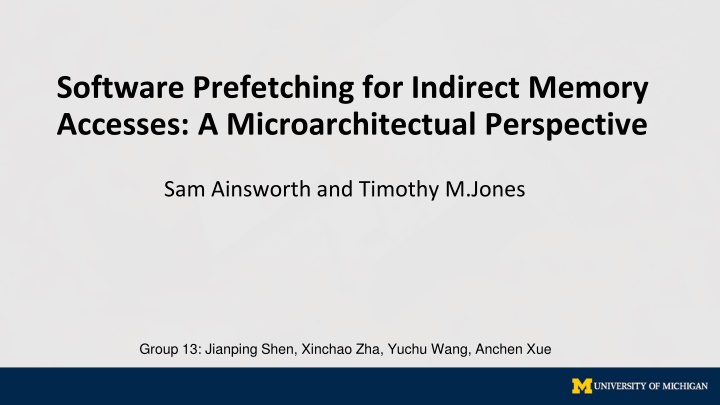
Efficient Software Prefetching Techniques for Indirect Memory Access
Explore the advantages of software prefetching for indirect memory accesses in improving processor performance by reducing cache misses. Understand the differences between hardware and software prefetching, prefetch potential, generation algorithms, and more.
Download Presentation

Please find below an Image/Link to download the presentation.
The content on the website is provided AS IS for your information and personal use only. It may not be sold, licensed, or shared on other websites without obtaining consent from the author. If you encounter any issues during the download, it is possible that the publisher has removed the file from their server.
You are allowed to download the files provided on this website for personal or commercial use, subject to the condition that they are used lawfully. All files are the property of their respective owners.
The content on the website is provided AS IS for your information and personal use only. It may not be sold, licensed, or shared on other websites without obtaining consent from the author.
E N D
Presentation Transcript
Software Prefetching for Indirect Memory Accesses: A Microarchitectual Perspective Sam Ainsworth and Timothy M.Jones Group 13: Jianping Shen, Xinchao Zha, Yuchu Wang, Anchen Xue
Introduction Memory wall has significant influence on Processor performance, 1 mem access 500 arithmetic ops Multiple Cache hierarchy help to minimize the memory latency by taking advantage of temporal and spatial locality Prefetch is a way to reduce cache miss
Hardware Prefetch V.S Software Prefetch Indirect access Sride access Sparse correlated access Software Prefetching Programmer uses data structure and algorithm to insert instructions into program to bring the required data in early Can support for irregular memory access Hardware Prefetching Implemented by hardware prefetcher Hardware prefetching is most effective for predictable, linear memory access patterns
Prefetch Potential Accesses to indirect_array are data- dependant on accesses to base_array The Address which used to access target array can be calculated by looking ahead base array in software Need to have an automatic compiler algorithm to schedule prefetch code The intuitive approach inserts only the prefetch at line 4, giving a speedup of 1.08x Prefetches to both the base array key_buff2 and the indirect array key_buff1 can achieve optimal performance, giving a speedup of 1.3x Choosing Prefetch Offset is important! Stall execution Pollute Cache
Software Prefetch Generation Algorithm Analysis To identify loads that can be profitably prefetched and determine the code required to generate prefetch instructions for them. Fault Avoidance software prefetches themselves cannot cause faults intermediate loads used to calculate addresses can Prefetch Generation & Scheduling insert new instructions into the code schedule prefetches by finding a look- ahead distance that is generous enough to prevent data being fetched too late, yet avoids polluting the cache and extracts sufficient memory parallelism to gain performance.
Target loads are those where it is possible to generate a prefetch with lookahead Example: A[I] can look ahead: A[I+offset] Analysis Start:Target Load End searching Induction variable Alloc Dependence graph backwards using a depth-first search Phi When find an induction variable, record all instructions that reference this induction variable (directly or indirectly) along each path to the load. ld find an induction variable ld Multiple paths different variables? only record innermost one End:reach out loop Inst in one path Start
Fault Avoidance Prefetches themselves cannot cause faults,intermediate loads used to calculate addresses can Example: the load from A[i+offset] to generate a prefetch of B[A] Ensure: look-ahead values are valid addresses!! if intermediate loads? contain valid data!! First: add address bounds checks into our software prefetch code, to limit the range of induction variables to known valid values Second: analyse the loop containing the load, and only proceed with prefetching if do not find stores to data structures that are used to generated load addresses within the software prefetch code Example: x[y[z[i]]], if there were stores to z, not be able to safely prefetch x.
Prefetch Generation & Scheduling increase the induction variable t: the total number of loads in a prefetch sequence l: the position of a given load in its sequence c: a microarchitecture-specific constant, which represents the look-ahead required for a simple loop, and is influenced by a combination of the memory latency and throughput (e.g., instructions-per-cycle (IPC)) of the system. High memory latency requires larger look-ahead distances to overcome, and high IPC means the CPU will move through loop iterations quickly, meaning many iterations will occur within one memory latency of time. create new copies of the software prefetch code instructions Take minimum value of the size of the data structure and the offset induction variable generate a software prefetch instruction instead of the final load
Prefetch Scheduling Continuing 2 prefetches are generated,So t = 2 First, l = 0, so offset = c by eq. (left) so issue a prefetch to key buff2[i+c]. For the second, l = 1, so we issue a prefetch to key buff1(buff2[i+c/2]) After c/t iteration: using a previously prefetched lookahead value key buff2[i+c] to index into key buff1, and issue a prefetch to key buff2[i+c+c/2] This has the property that it spaces out the look-ahead for dependent loads equally: each is prefetched c t iterations before it is used
Data Dependency Graph Example
Example Second ld
Example First ld
Experimental Setup Benchmarks for evaluation Integer Sort (IS) Conjugate Gradient (CG) RandomAccess (RA) Hash Join (HJ-2 & HJ-8) Graph500 Seq-CSR (G500) Systems Haswell (out-of-order) Xeon Phi (in-order) A57 (out-of-order) A53 (in-order)
Results and Discussions: Auto-generated Performance Performance improvement for different systems and benchmarks:
Results and Discussions: Look-Ahead Distance The speed-up improvement against the look-ahead distance is shown:
Summary An automated compiler pass is designed for the indirect memory accesses. Identify loads suitable for prefetching and insert the necessary code to calculate their addresses and prefetch the data; Look-ahead distances Offset = c(t - l) / t Speed-up (between 2.1 and 2.7 ) is close to optimal manual insertion of prefetches; Various factors are investigated regarding the software prefetch performance.






















